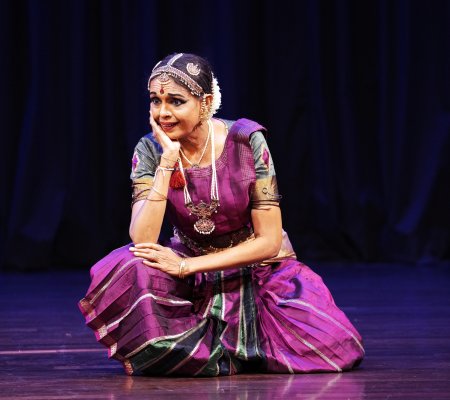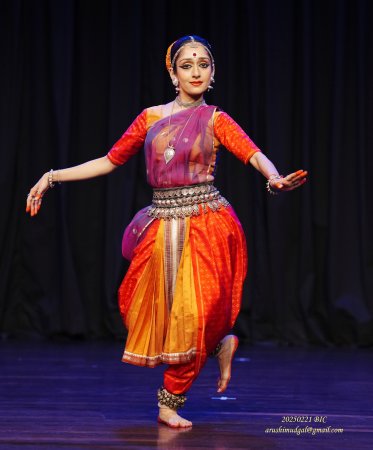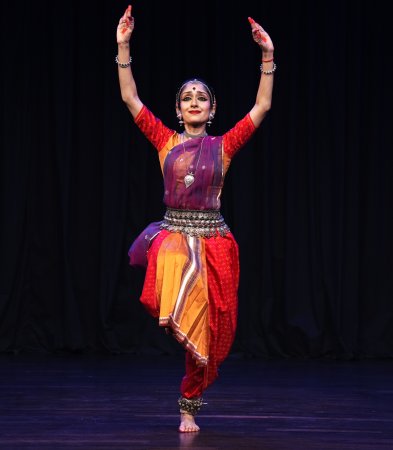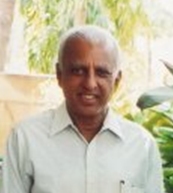
|   |

|   |
Suvai and Ataah: Relish and Resonance - Satish Suri e-mail: satishism@yahoo.co.in Photos: Prof. K.S. Krishnamurthy March 10, 2025 SUVAI - RELISH OF THE HEART BY PRIYADARSINI GOVIND On February 16, 2025, the Bangalore International Centre played host to a captivating program, spotlighting Bharatanatyam luminary Priyadarsini Govind. The event showcased Govind's Suvai - Relish of the Heart as part of the third edition of the Your Artist Festival, curated by Odissi dancer Bijayini Satpathy and Alif Arts Consultancy. Priyadarsini Govind, a Chennai-based maestro revered for her abhinaya, took the stage with Suvai, a performance designed to traverse an "emotional landscape" through lyrical compositions in multiple languages - Kannada, Telugu, Tamil, Maithili, Sanskrit, and Marathi. Known for her training under luminaries like Kalanidhi Narayanan and Swamimalai K Rajaratnam Pillai of the Vazhuvoor school, Govind's artistry lies in her ability to distil complex emotions into spontaneous, relatable moments. Suvai, meaning "relish" or "taste" in Tamil, lived up to its name by offering a feast of padams, javalis and poems that demand nuanced expression over the pure rhythmic display.  Priyadarsini Govind She opened with "Jagaddhodharana", a Kannada devaranama by Purandara Dasa that explores the dual emotions of vatsalya (maternal love) and bhakti (devotion) within the same bhava (emotional state). The poet's envy of Yashoda - able to see the Supreme Being (Parama Purusha, Lord Krishna) as her child - added a rich layer to Priyadarsini's abhinaya. Picture her eyes softening as Yashoda, then sharpening with the poet's envy - her face a canvas of maternal joy and spiritual ache. The vatsalya-bhakti blend, delivered, and showcased her spontaneity and emotional range, making the divine relatable. Dasamukha, which explores the ten faces of Ravana, is set to music by Dr. Rajkumar Bharathi. This work delves into Ravana's introspection and emotional turmoil, reflecting on his past grandeur and current downfall, with each face expressing a distinct reaction - sighing, trembling, sobbing, etc. - tied to his inappropriate love for Sita. The piece's premise - "what I was, alas what has become of me" - suggests a reflective arc. Ravana, once a mighty ruler and devotee of Shiva, now confronts his ruin, driven by his obsessive desire for Sita. Each of his ten faces becomes a canvas for emotion: one sighs deeply, perhaps mourning lost glory; another trembles, fearing retribution; a downcast face hides in shame; an open-mouthed stare conveys disbelief; a sobbing head grieves his choices. This personification of the ten heads transforms a mythological trope into a psychological study, with the dancer embodying Ravana's fractured self. The "inappropriate love for Sita" ties his downfall to a single, fatal flaw - lust over honour - ripe for dramatic interpretation through movement and music. Priyadarsini Govind used her abhinaya mastery to differentiate each face through subtle shifts in expression and posture, a challenge that made Dasamukha a standout piece. Patnam Subramania Iyer's "Samayam ide ra ra" (translated roughly as "The time has come, come in") in the lilting raga Behag - a raga known for its romantic and tender hues - lent itself beautifully to the abhinaya driven performance. As a javali, a light classical form, it thrives on expressive storytelling, making it a perfect vehicle for a dancer to explore the heroine's layered emotions: excitement, anticipation, passion, and the sting of moral conflict. The narrative unfolds with the heroine bidding farewell to her husband as he departs on a work-related journey. Her heart quickens - not with sorrow, but with a forbidden thrill - anticipating her lover's arrival. The music swells, a crescendo of Carnatic notes mirroring the heroine's rising heartbeat, and the dancer's grace transforms into something more urgent. Her eyes wide with yearning, dart toward an imagined horizon; her shoulders lift in a breath of hope. Yet, when her beloved hesitates at the doorstep - unwilling or unable to cross the threshold - the mood pivots. Here, the dancer's mastery of abhinaya shone. A subtle tilt of the head conveyed longing; a trembling hand betrayed frustration; a fleeting frown etched the bittersweet sting of unfulfilled desire. The audience was pulled into her plight, an empathetic witness to a woman wrestling with passion against the iron bars of societal norms. The conflicting emotions surged as the javali progressed. One moment she was radiant, her arms outstretched in a gesture of invitation - "Ra Ra" (come in) - her face aglow with the promise of stolen love. The next, she recoiled, her gaze downcast, as if the weight of her marriage anchored her to the floor. The dancer's vibrant attire contrasted sharply with these darker shades of emotion, amplifying the tension between outward poise and inner chaos. Through every mudra and every glance, she invited us to feel the heroine's duality: a wife bound by duty, a lover unbound by heart. Shivadeeksha presented a Nayika bound by a sacred vow - she has received Deeksha (initiation) and pledged her life to serve Lord Shiva, the austere deity of destruction and transformation. Yet, her heart secretly beat for Krishna, the playful, amorous flute player whose charm defies her discipline. The narrative ignited when Krishna, ever the mischievous lover, barged into her worship, disrupting her devotion with his audacious flirtation. The dancer embodying this Nayika masterfully juggled reverence and resistance, piety and passion, in a single breath. Her dialogue - "Go away! Why do you pull my saree? Why do you close my lips with yours? I am pledged to serve Shiva!" - became a choreography of defiance. Imagine her glaring at Krishna, her face a storm of indignation, yet her eyes betraying a flicker of longing. The abhinaya here was electric: she's duty-bound, yet his touch stirs her. As Krishna departs, the Nayika's resolve crumbles subtly. The music softens, fading into a mournful strain, and a "twinge of the heartstrings" ripples through her. Her gaze follows his retreat - slow, reluctant. This poignant close elevated Shivadeeksha beyond a simple love triangle; it was a meditation on the clash between spiritual commitment and human desire, rendered with allure by Priyadarsini Govind. "Sudarkodi pennai" from Tamil literature describes a young girl sharing her first love experience with her friend - a tender, mischievous moment involving a glass of water, a handheld, a fallen glass, and a quick excuse about hiccups. The poem captures the hand-holding, the glass falling, the mother's inquiry, the hiccup excuse, and the boy's mischievous laugh, tying it to childhood memories. The rendition by the artiste suggested a blend of innocence, playful mischief, and subtle romance, with emotions conveyed through delicate, relatable vignettes - much like a girl flustered by a boy's touch while offering water. The dance or poetic piece, "Ishopi Halahalam", titled Nindastuthi, explores Lord Shiva's act of swallowing poison, through a lens of questioning and satire, characteristic of the nindastuthi form - where praise is veiled in apparent criticism. The narrative delves into the buildup of "why did he swallow the poison," with speculative reasons like frustration or family discord, spotlighting the chaotic interplay of his family's vehicles (vahanas): the snake (Shiva's), the rat (Ganesha's), the peacock (Kartikeya's), and the lion (Parvati's). This culminates in Shiva consuming the poison to restore peace, with Parvati's intervention ensuring harmony. The narrative's heart lies in the "dichotomy of the vehicles," a whimsical yet tense tableau. This menagerie of vahanas became a choreographic circus, each animal's predatory instinct threatening familial collapse, underscored by a playful yet frantic score. Here the abhinaya of Priyadarsini shone, painting a cosmic household on the brink of chaos, balancing satire with reverence, chaos with calm.  Priyadarsini Govind In this rendition of a verse "Ekasmin shainaye", from Amaru Shatakam, the artiste transformed the poet's poetic snapshot - a lovers' quarrel dissolving into joy - into a vivid dance tableau, She embodied both lovers in a single frame, a testament to her abhinaya prowess. The question - Who will speak first? - played out in her eyes: darting sidelong glances, testing the other's resolve, each flicker a dare. Her face, a shifting mask, captured the ego's brittle edge. The turning point - a disturbance - arrived with a jolt. Her arms, once rigid, flowed outward in a graceful arc, hands meeting in a tender clasp to mime the embrace. The movement was fluid yet precise, a physical echo of the verse's emotional collapse, pulling the lovers together as if magnetized. The laughter that sealed the scene was where the artiste's rendition truly sparkled. It probed the human beneath the poetic, making the couple's fleeting rift and reconciliation feel timeless yet intimate. In the rendition of "Nee matale mayanura," the artiste transformed the Nayika's simmering frustration into a dynamic dance narrative, wielding abhinaya to channel her indignation and ultimate resolve. The buildup of questions - "Why these lies? Where are your promises?" - spilled forth in a flurry of abhinaya. The climax was the artiste's triumph. As the Nayaka lingered at the door, uncertain, the Nayika's resolve hardens, "Enough!" - and with a decisive sweep of her arm, she mimed shutting the door.The rendition elevated the javali beyond a scorned lover's rant. It was a study in empowerment: the Nayika, once swayed by promises, now asserts her agency, her frustration a spark that ignites rejection. The interplay of nritta and nritya was seamless - quick jathis for her agitation, slow, deliberate mudras for her resolve - drawing the audience into her emotional arc. This wasn't just a shutting of a door; it was a reclaiming of self, rendered with wit, grace, and a touch of theatrical flair. Priyadarsini Govind's conclusion with Tulsidas's "Kahan ke pataa de" was a masterstroke, weaving devotion, curiosity, and humanity into a poignant dance narrative that crowned her performance. As a seasoned Bharatanatyam artiste, renowned for her emotive abhinaya and elegant nritta, she brought this episode from the Ramayana to life with finesse. Enter the tribals, and Govind's rendition took flight. She became their collective curiosity - "Kahan ke pataa de?" ("Whence do you come?") - her face alight with wonder. As the tribals question, "Who are you? Why are you here?" her hands swept outward, then pointed inquisitively, her expressions toggling between awe and puzzlement. Rama's response was where Govind's storytelling peaked. Returning to his persona, she narrated their exile with understated dignity. Her hands traced a crown (kataka mudra), then fell as she mimed Kaikeyi's dictate, her gaze steady yet tinged with acceptance - "We abide by our mother's will." A slow, measured walk, joined by Lakshmana and Sita's mimed steps, conveyed their resolve. The music softened, a vocalist intoning Tulsidas' Hindi verse - "Kahan ke pataa de, kaun des tumhare" - its simplicity amplified Rama's humility. The trio's decision to leave shifted the mood and Govind deftly embodied the tribals' plea. Her arms stretched toward the departing figures, hands clasping in desperate entreaty,"Don't go!" A rapid sequence of gestures - palms shielding, then beckoning - conveyed their promise: "We will protect you, stay here." The climax was tender, leaving a lingering warmth. Her rendition elevated Tulsidas' verse into a dialogue of devotion and empathy. The tribals' fascination and plea contrasted exile's isolation, and Govind's abhinaya bridged their worlds. Her conclusion left the audience reflecting on Rama's sacrifice and the universal urge to shelter the divine, her vibrant presence a fitting capstone to a night of emotive dance. Priyadarsini Govind brought her performances to life, weaving her unparalleled abhinaya and elegant nritta with a recorded track that pulsed with the contributions of several singers and musicians. This rich auditory tapestry - layered with vocal ornamentation and instrumental flourishes - elevated the presentation, transforming it into a multisensory experience that crowned her performance. ATAAH BY ARUSHI MUDGAL On February 21, 2025, the Bangalore International Centre became a sanctuary of grace as Arushi Mudgal took the stage, her Odissi performance unfurling like a river of lyricism under the curatorial vision of Malavika Sarukkai and the Kalavaahini Trust's fifth All For Dance series managed by Shreya Nagarajan Singh. A disciple of her aunt, Guru Madhavi Mudgal, and shaped by the legacy of Kelucharan Mohapatra, Mudgal's artistry is a seamless blend of tradition and innovation, her technical virtuosity and creative fidelity breathing new life into the classical repertoire.  Arushi Mudgal In her opening statement, Arushi Mudgal beautifully captured the essence of Parvati Lasyam as depicted in the Sanskrit text by Acharya Brihaspathi. The imagery of Shiva and Parvati as cosmic dancers symbolizes the eternal interplay between Purusha (the cosmic consciousness or spirit) and Prakriti (the primal matter or nature). Parvati, in this context, is portrayed as the embodiment of divine beauty and grace, so captivating that even Shiva, the supreme ascetic and dancer, pauses in admiration. Her radiant beauty, described through metaphors like her snake-like braids outshining the serpents adorning Shiva, and her allure surpassing even Rati (the consort of Kamadeva, the god of love), highlights her as the epitome of perfection and charm. The poet's prayer to Parvati for everlasting auspiciousness reflects the deep reverence and devotion towards her as a source of divine blessings and harmony. This portrayal not only celebrated Parvati's physical beauty but also her spiritual significance as the nurturing and creative force of the universe, complementing Shiva's transformative and destructive energy. Together, they represent the balance and unity of opposites, essential for the cosmic order. "Aahlaad" was a radiant celebration of delight and joy, set to the evocative raga Sahana composed by her father Madhup Mudgal. Arushi entered with a buoyant grace, her tribhanga stance unfolding like a blossoming flower. The music, a lilting interplay of flute and mardala, set a joyful tone, its ascending notes sparking her fluid movements. Her arms wove intricate patterns - pataka and arala mudras tracing arcs of delight - while her footwork danced in sync with the rhythmic ebb, ghungroos chiming like laughter. The choreography, crafted by Arushi herself, radiated aahlaad (joy), her torso swaying with a lightness that lifts the spirit, a subtle innovation in pacing adding a fresh pulse to the classical form. Her eyes sparkled with infectious glee, drawing the audience into the rapture, each gesture a ripple of happiness. The piece peaked in a swift sequence - her body spiralling, then pausing in a poised chauka - embodying joy's fleeting yet profound essence. As the music softened, her final pose - a gentle tilt, hands offering a bloom - left a lingering warmth, a testament to her ability to blend tradition with a personal, joyous vision, captivating the audience with soul-stirring delight. "Advaita' was a profound item that delved into the philosophical concept of non-duality, exploring the interplay between the body (Nayika) and the soul (Nayaka) at the precipice of death. Arushi brought a lyrical and innovative approach to this dialogue, which was drawn from the poetic works of Dr. Rishiraj Pathak. The performance was elevated by a stunning multi-raga musical composition crafted by Madhup Mudgal, blending ragas like Jog and Lalit to create a hauntingly beautiful soundscape. The piece began with the mournful strains of a flute, setting the tone for the Nayika's plaintive plea: "I am like a shadow, inseparable." Through her abhinaya, Mudgal masterfully employed metaphors to convey the deep connection between the body and soul - comparing the flower to its fragrance, the bird to its flight, and the sun to its rays. Her torso swayed with fluid grace, her eyes glistened with shared emotions, and her voice, though silent, seemed to break with the weight of her realization: "I am incomplete without you." The Nayika's emotional turmoil unfolded in a poignant cascade of gestures and expressions - a push ("Don't go"), a release ("Go"), a clasp ("Stay"), and a resigned shrug ("Do as you please"). Her face flickered between anguish and intimacy, culminating in the tender acknowledgement, "I know you, my dear." Mudgal then transitioned seamlessly into the role of the Nayaka, embodying the soul with a resolute stance, calm eyes, and hands in varada mudra (gesture of blessing). The soul's response, echoing the wisdom of the Bhagavad Gita, reassured: "The cycle of birth and death is one truth, do not mourn." The music swelled, with the mardala (percussion) and vocals intertwining to highlight the composition's intricate beauty. In the final moments, Mudgal's pose fused the body and soul into a still embrace, symbolizing their ultimate unity. Her performance left the audience in awe, a testament to the profound lyricism and emotional depth of her artistry, and a reminder of life's inherent oneness. Arushi Mudgal's presentation of Chaliya, an Odia lyrical piece, beautifully captured the playful yet poignant dialogue between Lalitha, the sakhi of Radha, and Krishna, who is seated on the banks of the Yamuna, lost in contemplation. The performance was a vivid portrayal of the divine love triangle central to the Radha-Krishna lore, infused with Odissi's grace and expressive depth. Lalitha, embodying the role of Radha's messenger, approaches Krishna with a mix of concern and playful accusation. She begins by asking, "Shyama, is everything okay with you?" Krishna, ever the master of playful deceit, responds with feigned innocence, "I am just sitting by the Yamuna, enjoying the cool breeze." His nonchalant demeanour sets the stage for Lalitha's confrontation. With a sharp yet affectionate tone, Lalitha accuses him, "You are the ocean of deceit!" Her abhinaya conveyed both her exasperation and her deep understanding of Krishna's nature. She read the truth written on his face and declared, "I know the one you desire." Her words carried a warning, as she described Radha's dual nature - "She is as sweet as nectar but as deadly as poison." This metaphor underscored the intensity of Radha's love, which can enchant and consume in equal measure. Arushi Mudgal's portrayal of Lalitha was marked by a blend of lyrical elegance and dramatic flair. Her movements, from the subtle sway of her torso to the expressive gestures of her hands, brought Lalitha's character to life. The interplay of emotions - playfulness, concern, and a touch of admonishment - added layers to the narrative. Mudgal's ability to shift between the roles of the sakhi and Krishna, even if subtly, showcased her mastery of abhinaya and her deep connection to the Odissi tradition.  Arushi Mudgal . The finale of the performance titled 'Aikya' was a breathtaking culmination that harmoniously wove together the essence of Odissi and Kathak, symbolizing the ultimate union of these two classical dance forms. The concept of Aikya was beautifully realized through the seamless integration of Odissi's lyrical grace and Kathak's rhythmic precision, creating a transcendent experience for the audience. This feat was a testament to the artiste's extraordinary versatility, technical prowess, and deep understanding of both classical traditions. The ability to embody the essence of two distinct dance forms, while also integrating their musical elements, is a rare and awe-inspiring achievement. The artiste's journey through the Arasa of Odissi and the Tihai of Kathak, culminating in the sam or point of Aikya (oneness), was a masterful display of artistry. In Odissi, the artiste captured the lyrical grace, fluidity, and sculptural beauty of the form, with its characteristic Chauka and Tribhangi. The delicate sway of the torso, the expressive gestures of the hands, and the emotive storytelling through abhinaya brought the spiritual and poetic essence of Odissi to life. Simultaneously, Arushi seamlessly transitioned into the rhythmic intricacies of Kathak, executing the Tihai with precision and flair. The musical integration further elevated the performance. The Tihai, a rhythmic composition by Pt Birju Maharaj, and the Tarana, a melodic composition by Kumar Gandharva, were woven together in a way that highlighted the shared musical heritage of the two dance forms. The finale, arriving at the Sam, symbolized the ultimate union of the two styles. The dancer's final pose, a fusion of Odissi's Tribhangi and Kathak's poised elegance, embodied the concept of Aikya - oneness. The audience was left in awe of the artiste's ability to transcend the boundaries of form and style, creating a performance that was both a celebration of individuality and a testament to the power of unity. Through her artistry, Arushi demonstrated that while Odissi and Kathak may have distinct languages, they share a common soul - a soul that seeks to express the eternal truths of life, love, and spirituality. This solo performance was a true masterpiece, leaving an indelible mark on the hearts of all who witnessed it. The music ensemble for this performance was a vital force that elevated the artistry of the dancer, creating a rich and immersive experience for the audience. Rooted in Odissi's classical framework, the ensemble led by Sanvi Mudgal and Kushal Sharma on vocals, Shivashankar Satpathy on the mardala, and Rajat Prasanna on the flute, brought a profound depth and resonance to the performance. Each musician contributed to the ebb and flow of the narrative, enhancing the storytelling through their mastery of rhythm, melody, and expression.  Bangalore based Satish Suri is an avid dance rasika besides being a life member of the Music and Arts Society. |